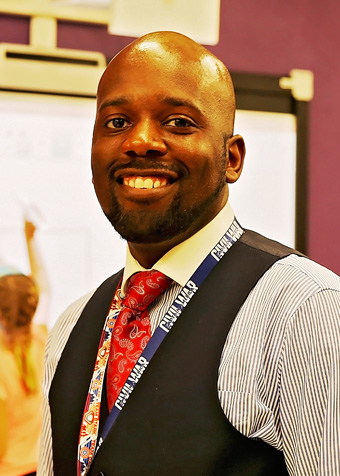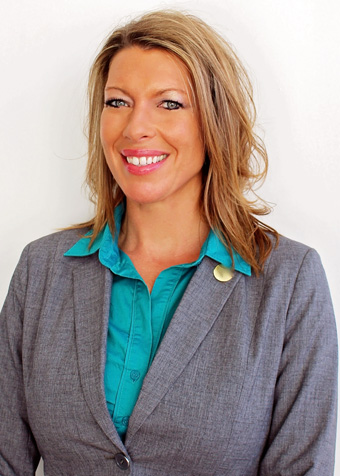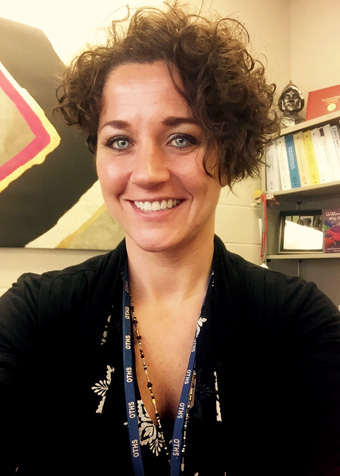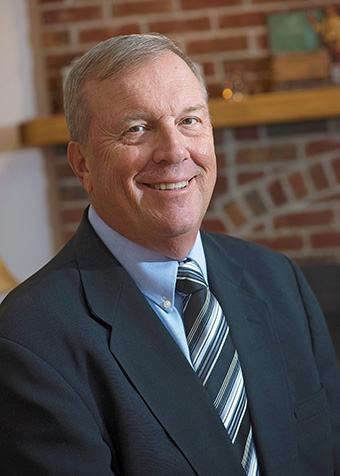McKendreans Address Issues, Challenges in Education
McKendree University is proud of its reputation for graduating students who go on
to become award winning, highly respected P-12 teachers, superintendents and school
administrators. Others bring years of experience as former teachers or administrators
to the University as members of our faculty and staff. Among the region’s best, many
have earned accolades from state and national professional organizations. We asked
five recently honored McKendreans about challenges facing today’s educators. Despite
their diverse experiences and perspectives, common themes emerged: the importance
of parental involvement, creating an environment of acceptance, the need for continual
improvement, and doing more with fewer resources. Meet the panel:

Reginald Duncan, M.A.Ed. ’12 is a finalist for the Presidential Awards for Excellence in Mathematics and Science
Teaching. He teaches fifth grade math, science and social studies at Wingate Elementary
School in Mascoutah, Ill.; is an I-STEM area teacher leader for the Regional Office
of Education #28; and serves on the Illinois Council of Teachers of Mathematics board
of directors.

Hattie (Doyle) Llewellyn ’94, principal at New Berlin High School in New Berlin, Ill., is president of the Illinois
Principals Association.

Tiffany (Schneider) Niedringhaus, M.A.Ed. ’08, special services coordinator at the O’Fallon Township High School Milburn Campus
in O’Fallon, Ill., received a 2017 “Trailblazer Award” from Region 5 of the Illinois
Alliance of Administrators of Special Education.

Dr. Jim Rosborg, director of the Master of Education degree program at McKendree University, received
the 2017 Herman Graves Award for outstanding support and service by the Illinois Principals
Association, Southwestern Region. He is the former superintendent of Belleville District
118 in Belleville, Ill.

Dr. Steve Webb ’92 represents Illinois on the Governing Board of the American Association of School
Administrators. He is a past president of the Illinois Association of School Administrators
and the Association of Illinois Rural and Small Schools. He is the superintendent
of Goreville Community Unit School District #1 in Goreville, Ill.
What is your greatest challenge as an educator or administrator?
Niedringhaus: Lack of parental involvement. Students are coming from so many different walks of
life that it is sometimes difficult to determine a best course of action for educating
the “whole” child. A solid home environment that includes parental involvement in
the school day can go a long way to help foster the home-school connection for a student.
Duncan: To continually improve my professional development and abilities without succumbing
to the inevitable feelings of “burn out” while juggling responsibilities inside and
outside of the classroom. This has become increasingly difficult over the years as
retirement age increases along with the cost of living, requiring many educators,
such as myself, to continually supplement their income with out-of-classroom activities
and professional responsibilities. This is a delicate dance many educators face as
we strive not to take anything away from our primary responsibility as educators for
our students.
Llewellyn: I really thought I had a solid perspective on what a principal did when I was a classroom
teacher, and felt like I was really prepared through my administrative coursework;
however, I have to admit, it did not take long for me to discover that I was REALLY
wrong! The role of an administrator is so complex. After 12 years in this position,
I am faced with challenges on a daily basis that I mentally add to my list entitled
“Things for Which NO Administration Program Can Prepare You.” Overall, my greatest
challenge is improvement and all of the requirements that come with the areas we need
to focus on: improve communities, families, schools, teachers, students, achievement
scores, self. This is a big challenge, and thankfully, support and resources are available
to help me.
Webb: As an administrator, it is making absolutely certain that our expectations for ALL
of our students are extraordinarily high because they look at us for reassurance that
they will be prepared for a tomorrow that is still being discovered. We must constantly
be looking to improve on what we do, such as exposing students and teachers to state-of-the-art
technology, innovative environments, and individual-centered learning so we concentrate
on what I call “need-based” educating rather than simply “norm-based.”
How do you create an environment of anti-bias and acceptance in your classroom or school?
Niedringhaus: Social media, I think, has desensitized our students so much. As frequently as we
address academics, I also feel it is imperative to teach lessons in empathy and understanding.
We pair students a lot in my building. As a special educator, I feel it important
for students to see each other as peers, regardless of their ability or disability.
We have extracurricular clubs that focus on pairing general education students with
special needs students, as well as clubs that operate during the school day that pair
students of all ability levels in order to decrease stigma.
Rosborg: An educator needs to provide opportunities for all children no matter what their
ethnicity or socio-economic background. The best way of providing the proper environment
is to give equal academic effort to all and insist on discipline rules that are consistent
to all students based on the district’s code of conduct.
All staff members should look for the good in each child and reinforce positive behaviors.
Parents need to be part of this process. Educators should provide parents with positive
components of their child’s behavior. In the classroom, take time to talk individually
to each child to find out what is going on in their lives and to stress strengths
that the child has. It’s important to make sure that basic needs of food, shelter,
clothing, and safety are met, as a child will not maximize their learning in reading,
writing and math if basic needs are lacking.
Duncan: This is of utmost importance to me and should be the top priority for all professional
educators. Diversity of thought and ideas are what, in my opinion, make our country
the greatest in the world. Our culture is built upon a foundation and rich history
of multicultural traditions, languages, ethnicity, genders, religions and people.
I strive to provide high quality, equitable mathematics instruction to my students
by reinforcing the importance of utilizing multiple representations and paths towards
solutions. Among my colleagues and through presentations at workshops and conferences,
I stress the vital role we have as facilitators of information not to subconsciously
emphasize or accentuate our own preferred strategies during instruction, effectively
skewing our students’ thought processes towards our own way of thinking.
Llewellyn: We strive to create a place where students are tolerant of differences and are free
to express themselves, resulting in culture that fosters confidence in being unique.
Our classroom teachers work hard to ensure the type of learning environment in which
students show mutual respect and openly express their opinions without of being harassed
or bullied.
Webb: Schooling does not take place in a vacuum. However, society seems to try to define
“normal” and then tries to create an assessment to determine who is normal and who
is not and compare those findings. We must teach kids that they are each unique and
that they set their own bar on normalcy—not some bureaucracy who sets arbitrary cut
scores. When that finally happens, we will be helping shape a world that embraces
diversity and uniqueness—a world that stops gauging normalcy and starts appreciating
that the talents of a child should not be measured by a test, but by their passion
to make a difference.
As schools encounter reduced funding and tighter state budgets, what are educators
doing to stretch limited resources?
Niedringhaus: We collaborate with one another to turn something that one teacher is doing into
something that another can use. Today’s tech also allows for a ton of resources online,
many of which are free.
Duncan: Teachers have always been a frugal and resourceful group, able to utilize our creativity
and problem-solving skills to make feasts out of famines where necessary. I have noticed
an increase in teachers relying upon free online resources and materials to provide
quality instruction.
Llewellyn: Our district has reduced support staff positions, reduced teaching positions, moved
from a block schedule to a traditional schedule in grades 6-12, reduced transportation
expenditures by combining routes, and made many changes to other departments to streamline
and reduce expenditures.
Webb: Unfortunately, schools with limited resources, generally those with low local assessed
valuation, have been forced to cut back on the very curricular and social programming
that research suggests helps kids the most.
They have increased class sizes, cut vocational programs and fine arts programs, and
limited quality professional development for teachers. All the while, those districts
with high property values continue to flourish. We, as a society, must do a better
job providing resources to schools so that they can offer more than just a basic academic
foundation and so that they can attract and retain high quality teachers—the two areas
that are perhaps the most unambiguous of all research findings when determining excellence.
“Making do” should never be good enough.
What is the difference between “learning” and “instruction” in today’s classroom?
In what ways are educators incorporating more active learning strategies?
Niedringhaus: Instruction is teacher-focused. Giving students knowledge that they will need for
their greater good—for the development of their mind and body. Learning is whole-student—mind,
body, and spirit are all engaged and the person they are becoming in this world is
changing. I am proud that our students “learn.” We have known for years that very
few students learn by being lectured TO. we are working more with the whole student—incorporating
tactile lessons, utilizing technology, getting kids out of their seats. Finding success
at every angle!
Rosborg: As a 46-year educator, I feel that learning and instruction are definitely tied together.
While it is sometimes tough for an educator to overcome a negative environment in
the home, the impact of the teacher and the principal is only second to a good parent
in a child’s academic learning process. A good teacher assimilates academic learning
using interdisciplinary procedures to cross subject matter to maximize a student’s
learning. In today’s society, that has incorporated so many multimedia opportunities,
the good teacher is creative to use these tools, along with basic skills that have
been in education for a long period of time.
Duncan: It’s often attributed to Mark Twain as saying, “I have never allowed my schooling
to interfere with my education.” I believe this axiom applies to this question. When
I was a student, we were instructed. Information was disseminated throughout the classroom
and the students that were most successful at recalling said information, or were
the best at “playing school,” were considered our best and brightest.
We have moved toward a student-led model for discovery and investigation of information,
while the teacher facilitates versus dictates the information throughout the lesson.
Students learn by doing versus watching and repeating what they are “taught,” allowing
for more engagement and involvement. Children are inquisitive by nature and this student-based
model nurtures high-quality learning experiences in school versus stifling independent
and diverse thought.
Webb: There was a day when teachers and administrators believed that “instruction” was
the dissemination of information. In today’s world, instruction is more coaching kids
on how to understand problems that are posed and how to attack and solve the problem
on their own using their talents and unique abilities. This differentiated approach
is only possible when a school has a culture and a passion for allowing teachers the
autonomy to create an atmosphere of need-based learning where a child WANTS to learn.
Llewellyn: The purpose of teaching is to see what the students are learning, which is accomplished
through effective formative assessments, effective questioning techniques, and providing
the opportunities for students to speak and share their learning. Educators incorporate
more active learning strategies through technology integration, literacy strategies,
such as think-pair-share, and their role changes from that of an instructor to a facilitator.
Rosborg Receives IPA's Herman Graves Award
In 1971, Dr. Jim Rosborg was student teaching at Marion (Ill.) Junior High School
when he met Herman Graves, a man who not only showed him what it meant to be a good
educator, but also inspired an award that Jim would receive 46 years later. The late
Mr. Graves was principal of Marion Junior High when Jim, then a 21-year-old college
student, got to know him and the importance of personal attention in an education
leader. “Mr. Graves was constantly visiting with teachers during their planning time
and was very supportive of both staff and students in good and bad times,” he said.
“He always had a smile on his face and didn’t let one bad situation ruin his day or
affect his dealings with other issues. He also took the time to get to know me and
offer his support. I remembered this when I became a principal myself at Jefferson
School in Belleville in 1985.”
An active member and leader of the Illinois Principals Association (IPA), Mr. Graves
continued to share his enthusiasm for the field with others beyond his own school.
He advocated for children’s education at local and state levels and promoted the IPA’s
role in developing quality administrators and schools.
To recognize his passion for students and the community of education leaders, the
IPA created its highest honor, the Herman Graves Award in 1991, with its namesake
as the first recipient. In September, Jim was surprised and thrilled to receive the
same honor as his former student teaching supervisor when the IPA presented him the
2017 Herman Graves Award.
An IPA member since early in his career, Jim says he is grateful for the support he
received from the organization right from the start and has sought to return that
guidance to his fellow educators. Only two years into his role as principal of Jefferson
School, he encountered an unexpected challenge when the first child with AIDS in southern
Illinois enrolled there. Jim leaned on the experience and support of IPA leaders and
has since contributed his own efforts to prepare school administrators through workshops
and state initiatives.
“My association with the IPA has helped keep me in the loop with current educational
trends in the field, which is very important to strengthening our M.A.Ed. program
here at McKendree,” Jim said. He spent 33 years as a teacher, principal, school administrator
and superintendent for Belleville District 118 before retiring in 2005. He continues
Mr. Graves’ mentoring legacy by preparing future teachers and administrators as the
director of McKendree University’s Master of Education degree program.

